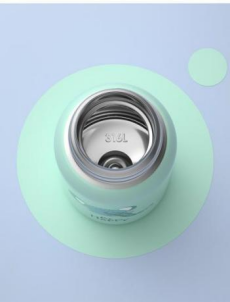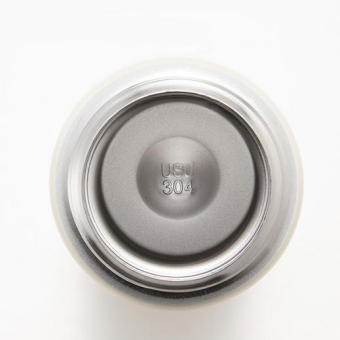201 VS 304 Stainless Steel, What’s the Difference Between Them?
Walking into a store, you’ll often see “304” or “316” stamped on the inner wall of stainless steel bottles—labels that have become synonymous with quality. But occasionally, you might spot “201” in a corner, priced significantly lower. Is it a great deal or a potential disappointment? Many shoppers wonder: if it’s all stainless steel, is 201 safe for insulated bottles? With concerns over health and affordability clashing, can 201 stainless steel, often overlooked by the industry, truly be a reliable choice?
Table of Contents
ToggleWhat Do Stainless Steel Labels Mean?
Stainless steel isn’t a single type of metal—it’s a large family of alloys. Its defining characteristic is at least 10.5% chromium, which forms a thin, protective oxide layer that helps prevent rust. The addition of elements like nickel, molybdenum, and manganese results in different grades, including 201, 304, 316, and 420. These numbers act like a unique identifier, influencing a material’s properties and determining where it’s best used.
201 stainless steel contains 5.5%-7.5% manganese but only 3.5%-5.5% nickel. This composition makes it more affordable since it uses less nickel, but it also impacts its performance. It has decent strength and hardness and is relatively easy to manufacture, but its lower nickel content reduces its resistance to corrosion. In humid conditions or when exposed to acidic or alkaline substances, it is more prone to rust. Because of this, 201 stainless steel is typically used in scenarios where durability isn’t a top priority, such as decorative elements and low-cost hardware.
304 stainless steel, on the other hand, has 18% chromium and 8% nickel, creating a well-balanced composition that enhances corrosion resistance. The protective oxide layer helps shield it from common beverages like coffee and tea.
Its higher nickel and chromium content make it highly resistant to moisture, mild acids, and alkalis, ensuring safety and long-term durability even with regular exposure to food and drinks. Additionally, its excellent toughness means it won’t easily crack or break during manufacturing processes like stretching or stamping. Because of these qualities, 304 stainless steel is widely used in food-grade containers, insulated bottles, and kitchenware, making it one of the most trusted materials in everyday life.
316 stainless steel builds upon 304 by adding 2%-3% molybdenum, significantly improving its resistance to corrosion. This addition allows it to withstand harsh environments, including exposure to strong acids, high temperatures, and extreme conditions.

As a result, 316 stainless steel is commonly used in high-end applications like medical instruments, marine engineering, and chemical processing. In these industries, material reliability is critical, and 316 stainless steel plays an essential role in ensuring long-term performance.
420 stainless steel is characterized by its high carbon content, giving it exceptional hardness, similar to that of surgical blades. This unique composition makes it highly durable in terms of mechanical strength.
However, compared to 304 and 316, its lower nickel and chromium levels mean it has weaker corrosion resistance, making it unsuitable for drinkware. Instead, it excels in dry environments where resistance to wear and hardness are more important. Because of these properties, 420 stainless steel is widely used in manufacturing tools, knives, and industrial components.
What Are the Key Differences Between 304 and 201 Stainless Steel?
1. Appearance Differences
At first glance, 304 and 201 stainless steel look quite similar. However, 304 stainless steel tends to have a smoother, shinier surface, while 201 has a slightly duller, rougher texture. The real difference becomes apparent over time. If a 201 stainless steel bottle is left with lemon water or saltwater for a while, rust spots may start forming on the inner walls, and the rim might develop a yellowish-brown oxidation layer.
In contrast, a 304 stainless steel bottle remains clean and unblemished even after months of use. This difference directly impacts consumer perception. No matter how stylish a bottle looks initially, visible rust or oxidation can make it feel cheap, undermining its perceived value. The choice of material ultimately affects how long a brand’s reputation can last.
2. Composition Differences
As discussed earlier, 201 stainless steel has a high manganese and low nickel content. While this reduces production costs, it also weakens the material’s resistance to oxidation. Nickel plays a crucial role in maintaining structural stability—without it, stainless steel becomes more vulnerable to corrosion, especially in humid or acidic environments. In contrast, 304 stainless steel contains 18% chromium and 8% nickel, forming a dense chromium oxide layer that acts like an invisible shield, significantly enhancing corrosion resistance.
3. Corrosion resistance
The biggest difference between 201 and 304 stainless steel is corrosion resistance. When exposed to mildly acidic liquids like lemon juice or coffee, 201 stainless steel can develop visible rust spots within 72 hours. Under the same conditions, 304 stainless steel can maintain its pristine appearance for months. The difference becomes even more dramatic in humid environments, such as coastal regions, where 201 stainless steel corrodes at an accelerated rate.

Mechanical performance also varies. Due to its higher manganese content, 201 stainless steel has slightly better flexibility, making it easier to shape into complex forms during production. However, this comes at the cost of durability—products made from 201 stainless steel are more prone to deformation over time.
On the other hand, while 304 stainless steel is slightly harder to process, its stable mechanical properties ensure that products retain their shape and integrity even after long-term use.
4. Cost Differences
For water bottle manufacturers, the choice between 201 and 304 stainless steel isn’t just about upfront material costs. The raw material price of 304 stainless steel is roughly three to four times higher than that of 201. However, opting for 201 to save costs can lead to higher expenses down the line due to product returns, warranty claims, and potential damage to brand reputation.
Ultimately, material selection is a balance between short-term cost savings and long-term reliability. While 201 stainless steel may offer immediate production advantages, 304 stainless steel provides the durability and stability necessary for sustained success.
Where are 304 and 201 Stainless Steel used?
1. 304 Stainless Steel is Essential for Food-Related Products
When it comes to food and beverage containers, 304 stainless steel is the undisputed choice due to its stable composition and excellent corrosion resistance.
With an optimal balance of 18% chromium and 8% nickel, it not only meets global food-grade safety standards but also effectively resists acidic liquids like coffee and fruit juices. This makes it the preferred material for food-grade utensils and drinkware, from commercial kitchen equipment to household thermoses.
For manufacturers, choosing 304 stainless steel isn’t just about compliance—it’s about ensuring consumer trust. A stainless steel bottle that never rusts at the rim creates a seamless, worry-free experience that strengthens brand loyalty.

In the high-end gift market, 304 stainless steel’s durability becomes even more valuable. Premium customized drinkware often carries sentimental or collectible value, where longevity is a key selling point. Due to its corrosion and oxidation resistance, a 304 stainless steel bottle can maintain its appearance and functionality for decades.
In contrast, using 201 stainless steel—even with high-end craftsmanship—risks the emergence of rust spots, which can quickly undermine a product’s premium positioning. Material choice reflects a brand’s commitment to quality, directly influencing its perceived value and market competitiveness.
Outdoor and sports environments pose even greater challenges for materials. Exposure to temperature fluctuations, rain, salt, and sweat requires stainless steel with superior resistance.
While 316 stainless steel offers the highest level of durability in extreme conditions, even standard 304 stainless steel can withstand most environmental stressors thanks to its protective chromium oxide layer. However, if 201 stainless steel were used instead, repeated expansion and contraction due to temperature changes could lead to cracks at the welded seams, causing leaks or loss of insulation performance. Such failures are especially critical for professional users, where product reliability directly impacts brand reputation.
2. Where is 201 Stainless Steel Used?
While 201 stainless steel offers cost advantages due to its high manganese and low nickel content, its limitations make it less suitable for insulated drinkware. The primary concern is long-term wear. Thermoses and water bottles are used daily, often with hot liquids and acidic beverages. Over time, 201 stainless steel can develop rust spots on the inner walls, which not only look unappealing but also create an environment where bacteria can thrive.
That said, 201 stainless steel still has practical applications in industries where material safety isn’t a primary concern. In decorative tubing, for example, its brightness and malleability make it ideal for intricate designs. Because these products don’t come into direct contact with food or liquids, corrosion resistance is less of an issue. In industrial piping, 201 stainless steel is often used to transport non-corrosive substances like air or clean water, where affordability is the key consideration. Additionally, shallow-drawn products like lampshades and decorative panels benefit from 201 stainless steel’s easy processing and cost-effectiveness. The common thread across these applications is that they do not require high corrosion resistance—decorative pipes don’t handle consumables, industrial pipes operate in controlled environments, and decorative panels are mainly for aesthetic purposes.
As a dedicated manufacturer of insulated bottles, Haers exclusively uses 304 and 316 stainless steel for production. This decision is rooted in a deep commitment to consumer health and product quality. 304 stainless steel not only meets international food safety standards but also features a self-repairing chromium oxide layer that prevents rust and metal ion release over long-term use. For even more demanding environments, 316 stainless steel offers enhanced corrosion resistance, making it particularly suitable for outdoor and high-intensity applications.
How to Distinguish Between 304 and 201 Stainless Steel?
1. Surface Texture and Markings
At first glance, 304 and 201 stainless steel may look similar, but closer inspection reveals subtle differences. 304 stainless steel has a smooth, fine texture with a uniform silvery-white luster, while 201 stainless steel appears slightly darker, with a rougher touch due to its higher manganese content. Additionally, reputable manufacturers typically mark 304 stainless steel products with identifiers like “SUS304” or “18/8,” while 201 stainless steel may be labeled as “SUS201” or “low-nickel stainless steel.”
However, surface treatments such as polishing or coating can sometimes mask these differences. As a result, appearance and markings should only be used for preliminary screening—more accurate verification requires additional testing methods.
2. Magnet Test
It is commonly believed that 201 stainless steel is magnetic while 304 stainless steel is not. Using a magnet to test for attraction is a simple method, but it is not entirely reliable.
Cold processing techniques such as stamping or stretching can introduce slight magnetism in 304 stainless steel, while some 201 stainless steel formulations (such as those with added copper) can reduce magnetic properties. Therefore, while the magnet test can serve as a quick reference, relying on it alone may lead to misjudgments.
3. Chemical Solution Testing
Chemical testing is one of the more reliable methods for distinguishing between 304 and 201 stainless steel. This method works by triggering a chemical reaction with elements like nickel and manganese in the steel. When a special testing liquid is applied to the surface, 201 stainless steel typically turns red, while 304 stainless steel shows little to no color change. Another common test involves applying a small amount of nitric acid: 201 stainless steel will produce a black corrosion mark due to nitrogen oxides, whereas 304 stainless steel remains largely unaffected.

While chemical testing is fairly accurate and suitable for quick on-site verification, factors such as solution storage conditions and expiration dates can impact results. For this reason, it should be used as a supplementary method rather than the sole basis for identification.
4. Third-Party Certification for Absolute Accuracy
For both brands and manufacturers, third-party testing offers the most authoritative verification. Advanced techniques such as spectroscopic analysis, salt spray tests, and heavy metal migration testing can provide a comprehensive assessment of stainless steel composition and performance. These certifications not only serve as a technical guarantee for manufacturers but also build trust with consumers by offering transparent and credible reports.

At Haers, every batch of stainless steel undergoes rigorous testing to ensure its corrosion resistance and compliance with food safety standards. Our products have earned international certifications such as SGS and FDA, reinforcing our commitment to quality and consumer well-being.
From food-grade kitchenware to high-end custom gifts, outdoor gear, and insulated water bottles, 304 stainless steel has set the industry benchmark for safety, durability, and corrosion resistance.
As a water bottle manufacturer, Haers remains dedicated to using only 304 and 316 stainless steel, providing tumbler OEM and ODM solutions to ensure material transparency and product reliability. Every bottle we produce is more than just a functional product—it represents our promise of health, quality, and long-lasting value. By maintaining strict material standards and rigorous testing protocols, we help our brand partners build strong market credibility and move toward a future of high-quality products.

